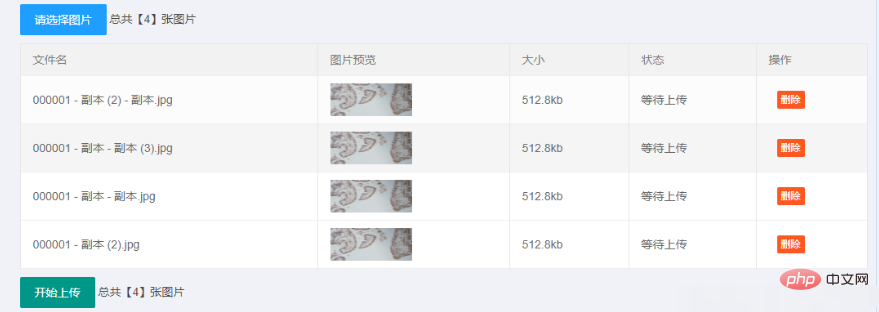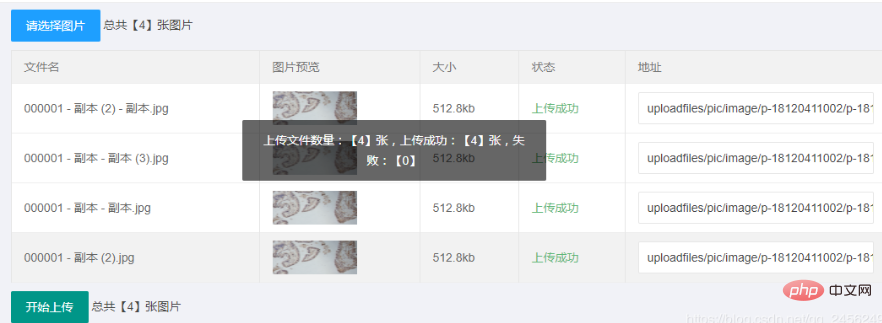 Backend Development
Backend Development
 PHP Tutorial
PHP Tutorial
 PHP combined with layui front-end to implement multiple image uploads
PHP combined with layui front-end to implement multiple image uploads
PHP combined with layui front-end to implement multiple image uploads
Jul 24, 2019 pm 02:05 PMphp combined with layui front-end to realize multi-image upload
Front-end html code
<div class="layui-upload">
<button type="button" class="layui-btn layui-btn-normal" id="testList">請選擇圖片</button>
<span class="num_pic"></span>
<div class="layui-upload-list">
<table class="layui-table">
<thead>
<tr>
<th>文件名</th>
<th id="pic">圖片預(yù)覽</th>
<th>大小</th>
<th>狀態(tài)</th>
<th id="cao">操作</th>
</tr>
</thead>
<tbody id="demoList"></tbody>
</table>
</div>
<button type="button" class="layui-btn" id="testListAction">開始上傳</button>
<span class="num_pic"></span>
</div>js code
<script type="text/javascript">
layui.use('upload', function() {
var $ = layui.jquery,
upload = layui.upload;
//多文件列表示例
var demoListView = $('#demoList'),
uploadListIns = upload.render({
elem: '#testList',
url: "{url('pic/index/upload')}",
accept: 'images',
acceptMime: 'image/*',
size: 8192,
multiple: true,
number: 400,
auto: false,
exts: 'jpg|png|jpeg',
bindAction: '#testListAction',
choose: function(obj) {
var files = this.files = obj.pushFile(); //將每次選擇的文件追加到文件隊列
//讀取本地文件
obj.preview(function(index, file, result) {
var tr = $(['<tr id="upload-' + index + '">', '<td>' + file.name + '</td>', '<td><img src="/static/imghw/default1.png" data-src="' + result + '" class="lazy" alt="' + file.name + '" style="max-width:90%"></td>', '<td>' + (file.size / 1014).toFixed(1) + 'kb</td>', '<td>等待上傳</td>', '<td>', '<button class="layui-btn layui-btn-xs demo-reload layui-hide">重傳</button>', '<button class="layui-btn layui-btn-xs layui-btn-danger demo-delete">刪除</button>', '</td>', '</tr>'].join(''));
//單個重傳
tr.find('.demo-reload').on('click', function() {
obj.upload(index, file);
$("#upload-" + index).find("td").eq(2).html((file.size / 1014).toFixed(1) + 'kb');
});
//刪除
tr.find('.demo-delete').on('click', function() {
delete files[index]; //刪除對應(yīng)的文件
tr.remove();
uploadListIns.config.elem.next()[0].value = ''; //清空 input file 值,以免刪除后出現(xiàn)同名文件不可選
});
demoListView.append(tr);
$(".num_pic").text("總共【" + demoListView.find("tr").length + "】張圖片");
});
},
done: function(res, index, upload) {
if(res.code == 0) { //上傳成功
$("#cao").text("地址");
var tr = demoListView.find('tr#upload-' + index),
tds = tr.children();
tds.eq(3).html('<span style="color: #5FB878;">上傳成功</span>');
tds.eq(4).html('<input type="text" name="imgs[]" value="' + res.file + '" class="layui-input" />'); //清空操作
return delete this.files[index]; //刪除文件隊列已經(jīng)上傳成功的文件
}
this.error(index, upload);
},
allDone: function(obj) { //當文件全部被提交后,才觸發(fā)
layer.msg("上傳文件數(shù)量:【" + obj.total + "】張,上傳成功:【" + obj.successful + "】張,失敗:【" + obj.aborted + "】", {
time: 3000
});
console.log(obj.total); //得到總文件數(shù)
console.log(obj.successful); //請求成功的文件數(shù)
console.log(obj.aborted); //請求失敗的文件數(shù)
},
error: function(index, upload) {
var tr = demoListView.find('tr#upload-' + index),
tds = tr.children();
tds.eq(2).html('<span style="color: #FF5722;">上傳失敗</span>');
tds.eq(4).find('.demo-reload').removeClass('layui-hide'); //顯示重傳
}
});
});
</script>Backend code
public function uploadAction(){
$file=$_FILES['file'];
$root_url = 'uploadfiles/pic/image/';
if (!is_uploaded_file($file['tmp_name'])){
$data = array('code'=>1,'msg'=>"錯誤");
exit(json_encode($data,0));
}
/* $root_url.=date('Ymd').'/';*/
$ext = pathinfo($file['name']);
$num=makenum($this->memberinfo['id']);
$root_url.=$num.'/';
if (!is_dir($root_url)) {
mkdir($root_url,0777, true);
}
$pa=file_list::get_file_list($root_url);
$na=count($pa) + 1;
if ($na<10){
$name=$num.'-000'.$na;
}elseif($na<100){
$name=$num.'-00'.$na;
}elseif($na<1000){
$name=$num.'-0'.$na;
}else{
$name=$num.'-'.$na;
}
$n=$root_url.$name.".".$ext['extension'];
$result=move_uploaded_file($file['tmp_name'],$n);
if ($result){
exit(json_encode(array("code"=>0,"msg"=>"ok","file"=>$n,"size"=>$file['size']),0));
}else{
exit(json_encode(array("code"=>1,"msg"=>"false","file"=>$n,"size"=>$file['size']),0));
}
}
Upload effect:


##
The above is the detailed content of PHP combined with layui front-end to implement multiple image uploads. For more information, please follow other related articles on the PHP Chinese website!

Hot AI Tools

Undress AI Tool
Undress images for free

Undresser.AI Undress
AI-powered app for creating realistic nude photos

AI Clothes Remover
Online AI tool for removing clothes from photos.

Clothoff.io
AI clothes remover

Video Face Swap
Swap faces in any video effortlessly with our completely free AI face swap tool!

Hot Article

Hot Tools

Notepad++7.3.1
Easy-to-use and free code editor

SublimeText3 Chinese version
Chinese version, very easy to use

Zend Studio 13.0.1
Powerful PHP integrated development environment

Dreamweaver CS6
Visual web development tools

SublimeText3 Mac version
God-level code editing software (SublimeText3)

Hot Topics
 How to get the current session ID in PHP?
Jul 13, 2025 am 03:02 AM
How to get the current session ID in PHP?
Jul 13, 2025 am 03:02 AM
The method to get the current session ID in PHP is to use the session_id() function, but you must call session_start() to successfully obtain it. 1. Call session_start() to start the session; 2. Use session_id() to read the session ID and output a string similar to abc123def456ghi789; 3. If the return is empty, check whether session_start() is missing, whether the user accesses for the first time, or whether the session is destroyed; 4. The session ID can be used for logging, security verification and cross-request communication, but security needs to be paid attention to. Make sure that the session is correctly enabled and the ID can be obtained successfully.
 PHP get substring from a string
Jul 13, 2025 am 02:59 AM
PHP get substring from a string
Jul 13, 2025 am 02:59 AM
To extract substrings from PHP strings, you can use the substr() function, which is syntax substr(string$string,int$start,?int$length=null), and if the length is not specified, it will be intercepted to the end; when processing multi-byte characters such as Chinese, you should use the mb_substr() function to avoid garbled code; if you need to intercept the string according to a specific separator, you can use exploit() or combine strpos() and substr() to implement it, such as extracting file name extensions or domain names.
 How do you perform unit testing for php code?
Jul 13, 2025 am 02:54 AM
How do you perform unit testing for php code?
Jul 13, 2025 am 02:54 AM
UnittestinginPHPinvolvesverifyingindividualcodeunitslikefunctionsormethodstocatchbugsearlyandensurereliablerefactoring.1)SetupPHPUnitviaComposer,createatestdirectory,andconfigureautoloadandphpunit.xml.2)Writetestcasesfollowingthearrange-act-assertpat
 How to split a string into an array in PHP
Jul 13, 2025 am 02:59 AM
How to split a string into an array in PHP
Jul 13, 2025 am 02:59 AM
In PHP, the most common method is to split the string into an array using the exploit() function. This function divides the string into multiple parts through the specified delimiter and returns an array. The syntax is exploit(separator, string, limit), where separator is the separator, string is the original string, and limit is an optional parameter to control the maximum number of segments. For example $str="apple,banana,orange";$arr=explode(",",$str); The result is ["apple","bana
 JavaScript Data Types: Primitive vs Reference
Jul 13, 2025 am 02:43 AM
JavaScript Data Types: Primitive vs Reference
Jul 13, 2025 am 02:43 AM
JavaScript data types are divided into primitive types and reference types. Primitive types include string, number, boolean, null, undefined, and symbol. The values are immutable and copies are copied when assigning values, so they do not affect each other; reference types such as objects, arrays and functions store memory addresses, and variables pointing to the same object will affect each other. Typeof and instanceof can be used to determine types, but pay attention to the historical issues of typeofnull. Understanding these two types of differences can help write more stable and reliable code.
 Using std::chrono in C
Jul 15, 2025 am 01:30 AM
Using std::chrono in C
Jul 15, 2025 am 01:30 AM
std::chrono is used in C to process time, including obtaining the current time, measuring execution time, operation time point and duration, and formatting analysis time. 1. Use std::chrono::system_clock::now() to obtain the current time, which can be converted into a readable string, but the system clock may not be monotonous; 2. Use std::chrono::steady_clock to measure the execution time to ensure monotony, and convert it into milliseconds, seconds and other units through duration_cast; 3. Time point (time_point) and duration (duration) can be interoperable, but attention should be paid to unit compatibility and clock epoch (epoch)
 How to pass a session variable to another page in PHP?
Jul 13, 2025 am 02:39 AM
How to pass a session variable to another page in PHP?
Jul 13, 2025 am 02:39 AM
In PHP, to pass a session variable to another page, the key is to start the session correctly and use the same $_SESSION key name. 1. Before using session variables for each page, it must be called session_start() and placed in the front of the script; 2. Set session variables such as $_SESSION['username']='JohnDoe' on the first page; 3. After calling session_start() on another page, access the variables through the same key name; 4. Make sure that session_start() is called on each page, avoid outputting content in advance, and check that the session storage path on the server is writable; 5. Use ses
 How does PHP handle Environment Variables?
Jul 14, 2025 am 03:01 AM
How does PHP handle Environment Variables?
Jul 14, 2025 am 03:01 AM
ToaccessenvironmentvariablesinPHP,usegetenv()orthe$_ENVsuperglobal.1.getenv('VAR_NAME')retrievesaspecificvariable.2.$_ENV['VAR_NAME']accessesvariablesifvariables_orderinphp.iniincludes"E".SetvariablesviaCLIwithVAR=valuephpscript.php,inApach





